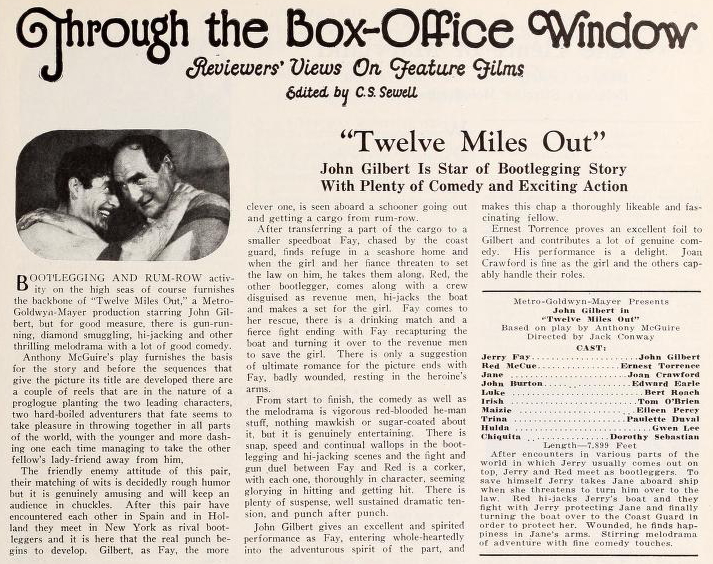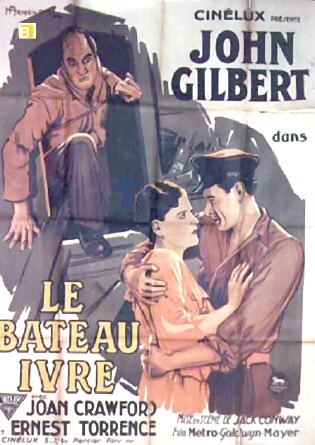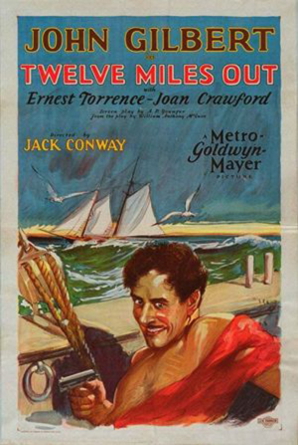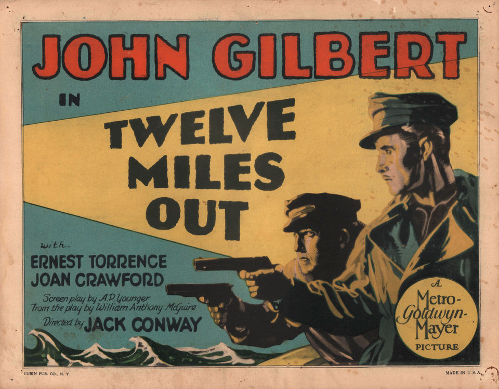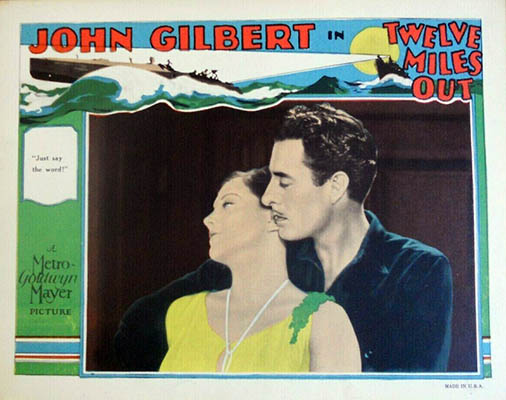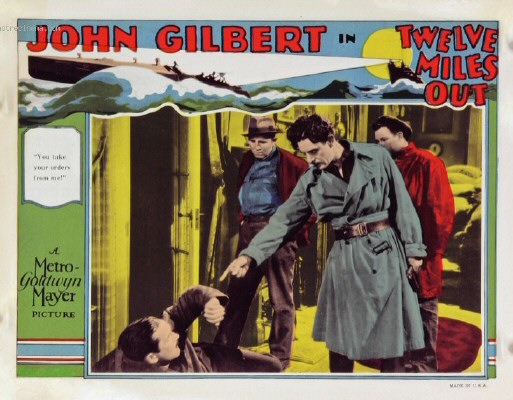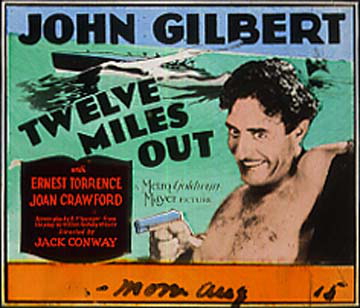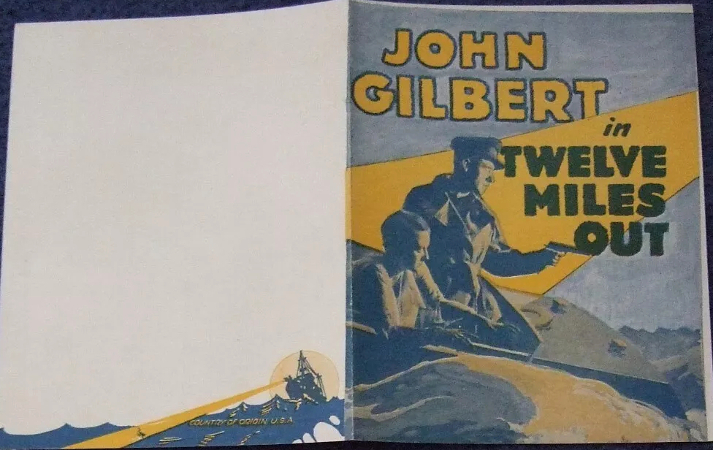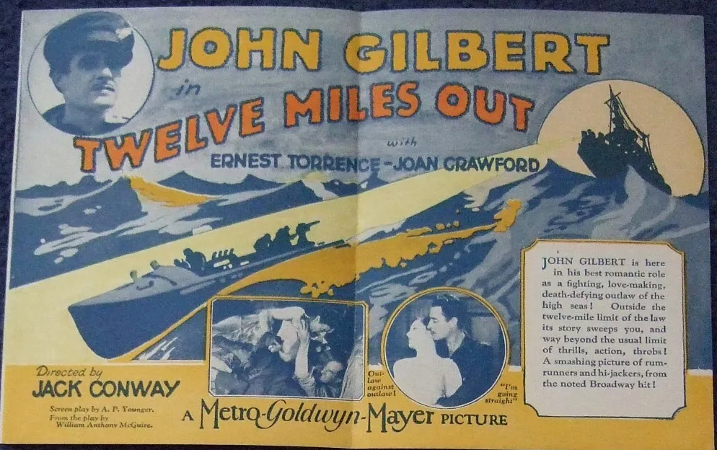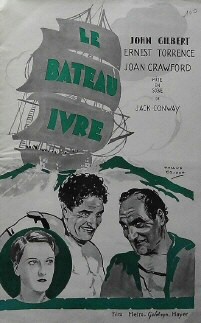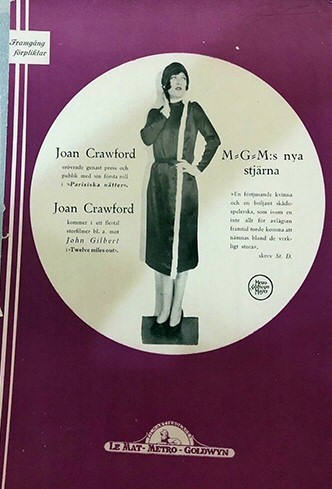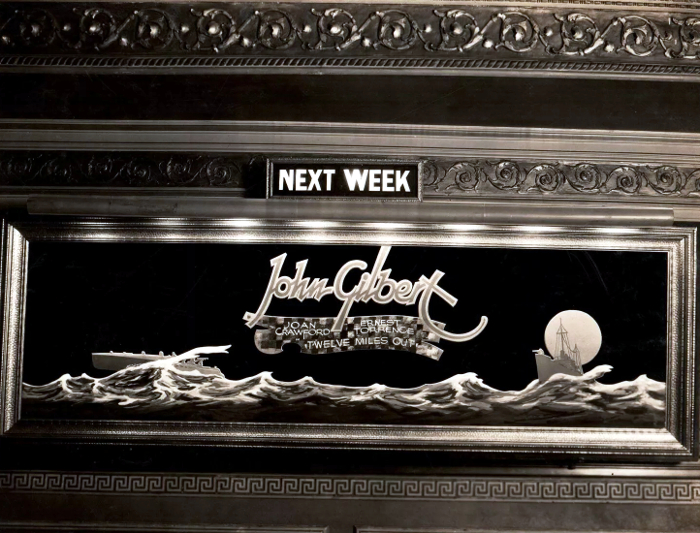|
 Tom C. (December 2021) Tom C. (December 2021)Rating:   - 1/2 of 5 - 1/2 of 5
Twelve
Miles Out (1927), based on the 1925 Broadway play of the same name, is one in a series of movies that a
young Joan made in 1927 and
1928 where she plays the female lead, paired with MGM's top male
stars in an effort to increase the profile of the rising young
starlet. In this film, JC plays
second fiddle to John Gilbert, then among the brightest stars in
silent cinema. For a long time he was largely known for being left at
the altar by Garbo and being a classic example of a silent star whose
career cratered with the advent of sound. Happily, the past decades have
seen restoration of some of his films, including The Big Parade (1925)---the Gone with the Wind of the Silent Era---and Bardelys the
Magnificent (1926), in which Joan had a bit role.
Here,
Gilbert
plays Jerry, a rum runner who, while on the lam from the Coast Guard,
invades the house of Joan's character "Jane" and her fiancé, John
(played by Edward Earle).
Jane and her beau reproach the rum runners, but as Gilbert points out,
if people like them didn't illegally imbibe, guys like him would be out
of business. Fair enough. The thugs mean to lay low until the heat is
off, but when one of the gang shoots the butler, who was attempting to
escape, things take a darker turn. Jerry thus kidnaps the duo.
While
on the ship, Jane's boyfriend John
is shown to be wanting in intestinal fortitude, refusing to engage in a
gun duel with Jerry for the honor of his lady. John then mysteriously
disappears from the rest of the film. Jane initially loathes Jerry, but
warms up to him once her boyfriend disappears and another
baddie, "Red" (played by Ernest Torrence), appears, casting his lecherous eye in Jane's direction. After
a drinking contest, Jerry and Red engage in a battle royale covering nearly the
entire ship. Jerry is able to keep Red at bay until the Coast Guard
shows up. No traditional happy ending, though... Jerry with his last breath asks Jane
if she can
forgive his earlier transgressions and give him a kiss...
Like
many of her films in this time period, Joan is there to look pretty,
and support the star. And, when needed, display moxie, standing up to
Jerry despite his attempts to terrorize her. Joan also sports an
interesting short hairdo, unlike any other movie of hers that I can
recall.
The
copy of this movie floating around on the internet is poor quality. It
appears to be missing some reels, just like the early Joan flick Pretty
Ladies (1925), so the continuity is off. For example, Dorothy Sebastian
is listed as part of the cast, but not seen. The internet version is
58.5 minutes, but IMDB lists it at 1:25. But, it's not entirely lost
like many of Joan's silent films, so we have to be thankful for that.
Overall, 2.5 stars.
 Shane Estes (September
2010) Shane Estes (September
2010)
Rating:
   of 5 of 5
I
finally managed to get my hands on a (ridiculously overpriced) copy of
this film on VHS that I’m guessing had an unofficial limited release at
some point in the 1990’s through Grapevine Video. It was transferred
from a “rare 9.5 mm French print.” This makes for a few interesting
twists on the film. First of all, the intertitles are literally
translated from the French and not the original American versions, so
many of the lines come off sounding rather artificial, and there are
many grammatical errors as well, with lines such as, “How many times I have told you not to use violence.” Secondly,
this is the French version of the film, and from what I’ve read, the
censors of the era were at times surprisingly more conservative in
Europe than in America, so the “steamy” scene from the film that we see
in
the Ultimate Movie Star documentary where John Gilbert
forcibly kisses Joan has unfortunately been edited. There are clearly
some plot variations as well, because at the end of the film when
Gilbert is lying there dying, he says, “Let me believe you are not too
angry with me by kissing me… just once…,” and she does; but in the
American version that would not have been their first kiss. Lastly,
there is clearly a missing reel or missing footage, because the run time
is supposed to be 85 minutes and this version is only about an hour,
which causes a little bit of confusion; but the basic story is still all
there. So
with all that said, what a great little film! The overall quality of
the film is better than I anticipated. It’s not as good as The Unknown, but comparable to Spring Fever in that it has a lot of damage, but it’s still definitely watchable. I’m a silent film buff
and a huge Joan fan, so I really ate this one up. It’s really quite an
interesting film. It has kind of an action/adventure feel to it, similar
in style to Across To Singapore, which also features the villainous Ernest Torrence. Here
Gilbert plays Jerry, a crafty bootlegger with a sense of style, who
takes over a house along the shore in order to evade the coastguard.
Joan plays Jane, the fiancé of the man who owns the house being taken
over. After threatening to tell the authorities, Gilbert takes the
couple hostage onto his boat. We never find out what happens to Joan’s
fiancé! He just kind of disappears after they are on the boat. I suppose
that part was on the missing reel! Anyway, Joan doesn’t seem to be all
that upset by it. Eventually she starts to fall for Gilbert and likes
the sense of protection she gets from him, unlike from her fiancé, who was
depicted as very weak and sickly and not very noble. Then enters Red,
the evil rival of Gilbert, played beautifully by Torrence. I read a
couple of reviews from the day that said Torrence upstages Gilbert in
this and completely steals the show. I
don’t know if I entirely agree with that. Torrence adds an element of
danger and suspense to the film, but Gilbert is definitely the star
here, and despite his big nose, Gilbert has a certain charm and charisma
and sexiness that I quite enjoy. I
like Crawford’s look in this. It’s a bit different from her other
silent film work in that her hair is very short. I think she pulls it
off great. She has an important presence throughout the film; however,
her acting range is very limited here, most likely just due to the
script. She’s basically Gilbert’s bitch and her role is therefore
limited, but apparently it calls for lots and lots of glaring and
shooting the evil eye at people, but it comes off nicely. I especially
enjoy the ending of this film. It’s sad; both rivals die and Joan is
left alone, which kind of makes it stand out among other films of the
day. Motion Picture Magazine even commented in the October 1927 issue that “The film breaks the bounds of what might be called movie tradition by having a sad ending.” I
don’t imagine they would have been able to get this film past the
censors after the Hays Code went into effect in 1934. I think the
content would have been a bit too racy. Apparently the French thought
so. A couple of funny lines from the film are when Joan’s husband says, “As
an American citizen I demand to know what time it is!” and when Gilbert
says to Torrence, “I know a girl in Honolulu that would find you
beautiful. Of course she’s as blind as a mole.”
Overall, a handsome film
with a fine production and a simple plot, set on a boat with a bunch of
dangerous bootleggers. Almost lost to time, Twelve Miles Out remains an intriguing entry in Crawford’s silent picture catalogue. Well worth watching!
 Stephanie
Jones
(January 2006) Stephanie
Jones
(January 2006)
Rating:
  - 1/2 of 5 - 1/2 of 5
I
wonder if different versions of Twelve were released in Europe
and in the U.S. My French print is about 58 minutes long and several
plot points vary from the synopsis in the entry in the Films
of Joan Crawford book, which lists the running time as 85 minutes.
My print could just be missing the first reel, but that wouldn't
account for plot variations that also occur later in the film...
At
any rate, my print begins with the rum-running Jerry (John
Gilbert) and gang making a mad dash from the US Coast Guard and
taking refuge in a home occupied by the upper-class Jane (Joan)
and her snooty, weak fiance. When the couple threatens to report
Jerry upon his departure, he takes them prisoner aboard his boat.
After a few confrontations between the cowardly fiance and the good-at-heart
Jerry, and a few piercing glances between Jane and Jerry (truly,
no one can compare to Joan Crawford and Jack Gilbert when it comes
to Intense Stares), Jane realizes she loves Jerry. (At which point
the fiance inexplicably disappears---I've watched the film twice
now and still can't figure out what happened to him! Did he fall
overboard?!)
Once
the spark between Jane and Jerry is kindled, though, the real
trouble ensues when Jerry's old bootlegging rival and sometime buddy
Red (Ernest Torrence) shows up. This hulking brute immediately starts
trying to manhandle Jane and claim her for his own. To protect her,
Jerry first devises a drinking contest, hoping to force Red to pass
out and forfeit the girl. When this doesn't work, Jerry secretly
sends an SOS to the Coast Guard, even though this means he'll give
up his own freedom...
This
film is all Gilbert's. Sorry to say, I haven't seen him in anything
besides this aside from Queen Christina, but I was captivated and impressed with his performance
here. He's a hearty, confident physical actor who's also capable
of great facial expressiveness and subtlety. Granted, sometimes
the Intense Stares are a tad bit over-the-top, but these are more
than countered by other thoughtful moments when he's quietly
looking at Jane, or grinning at her engagingly, or exhibiting disappointment with
himself.
I've
got to admit that Joan seems slightly overpowered onscreen
by his charisma. And the camera notices, too: There are many more
close-ups of Gilbert than of Joan, which doesn't just have to do
with the fact that he was the bigger star; in this film at least,
he is simply more interesting to look at. Joan doesn't have
much to do here except stand around a bit stiffly (with the occasional
fainting spell), looking at first disdainful and then sadly in love,
and, finally, frightened by the Red menace. All of which she does
more than competently; it's just that she seems a bit boyish or
kid-like here, without the raw glamour and sex appeal that Gilbert
exudes.
Another
powerful presence here is Ernest Torrence (also Joan's co-star in
'28's Across to Singapore and '29's Untamed). Egads,
what a big, leering galoot of a man! His scenes with Gilbert, whether
they're brawling or trying to outwit each other, are intense and
interesting because of both the psychological and physical acting
power each possesses. As described in the Films of JC
book synopsis, the first part of the movie focuses on Jerry and Red's
rivalry, as they compete for money, women, and daredevil glory around
the globe. Maybe seeing more of this psychological backstory of
the two men would have made this a 3-star rather than 2-1/2-star
film for me. As is, it's a decent adventure tale, simply plotted, with
a love interest thrown in, with points given for the acting
chops of the two male leads.
Joan
would have to develop for a few more years before she'd have
the onscreen wattage of Gilbert (or of Lon Chaney, for that matter,
with whom she also co-starred in 1927). By the time she began appearing
with Clark Gable in 1931, she had definitely summoned the inner
resources necessary to hold her own and project against a strong,
charismatic male co-star. Here, though, she's still a bit of a lightweight.
|
 MGM Silent. 85 minutes
(8 reels).
MGM Silent. 85 minutes
(8 reels).
